Blond, German actress Charlotte Susa (1898-1967), was a major operetta star of the German-speaking world, and also a popular femme fatale of the German silent and early sound film.
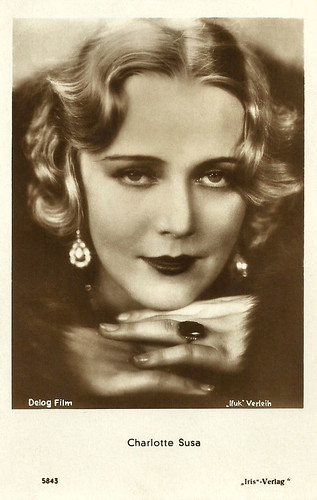
Austrian postcard by Iris Verlag, no. 5843. Photo: Verleih Ifuk Film / Delog Film. Charlotte Susa in Zapfenstreich am Rhein/Tattoo on the Rhine (Jaap Speyer, 1930).
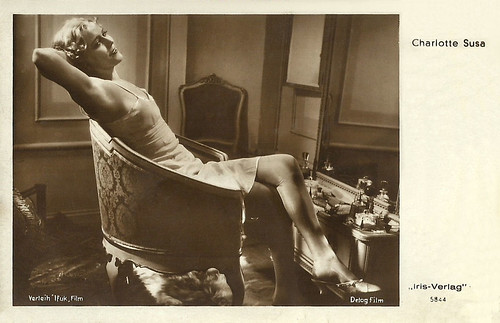
Austrian postcard by Iris Verlag, no. 5844. Photo: Verleih Ifuk Film / Delog Film. Charlotte Susa in Zapfenstreich am Rhein/Tattoo on the Rhine (Jaap Speyer, 1930).
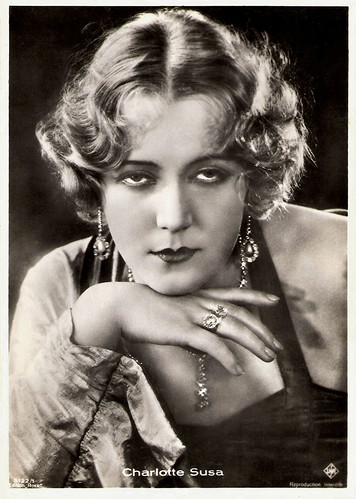
French postcard by Ross, no. 5122/1, 1930-1931. Photo: Ufa. Charlotte Susa in Der Tiger/The Tiger Murder Case (Johannes Meyer, 1930).
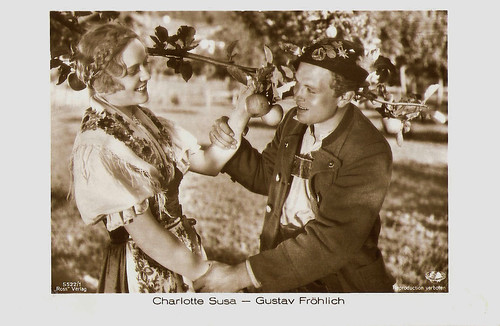
German postcard by Ross Verlag, no. 5522/1, 1930-1931. Photo: Deutsche Universal Film. Publicity Still for Zwei Menschen/Two People (Erich Waschneck, 1930) with Gustav Fröhlich.
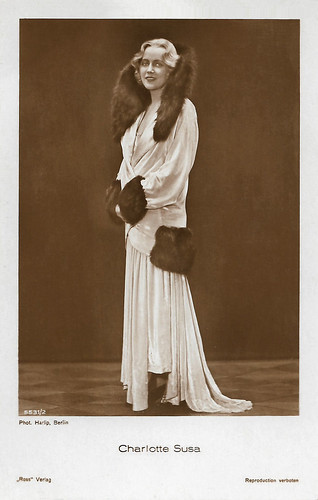
German postcard by Ross Verlag, no. 5531/2, 1930-1931. Photo: Harlip, Berlin.
Charlotte Susa (sometimes written as Suza) was born Charlotta Wegmüller near Memel, Germany (now Klaipeda, Lithuania).
In 1915, she first appeared at a stage in Tilsit. She chose her mother's maiden name, Susa, as her stage name and began a successful career as a singer and actress at different German Opera and Operetta stages.
She was as well a superior singer as a competent dramatic actress. In 1926, director Richard Eichberg spotted her for the cinema. Susa made her film debut in the German silent film Der Prinz und die Tänzerin/The Prince and the Dancer (Richard Eichberg, 1926) opposite Hans Albers.
More silent films followed like Arme kleine Colombine/Poor Little Columbine (Franz Seitz, 1927), Die Pflicht zu schweigen/The Obligation to Remain Silent (Carl Wilhelm, 1928), and Du sollst nicht stehlen/Thou Art Not Steal (Victor Janson, 1928).
Susa became famous for her roles as a femme fatale in films like Sünde und Moral/Sin and Morals (Erich Kober, 1929), and Erotikon/Seduction (Gustav Machatý, 1929).
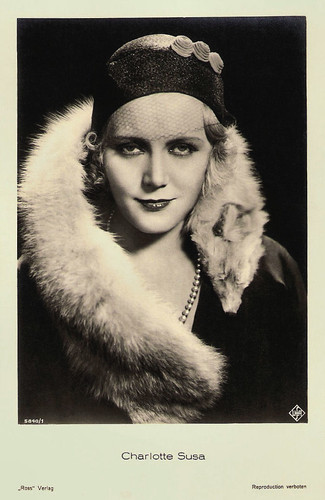
German postcard by Ross Verlag, no. 5840/1, 1930-1931. Photo: Ufa.

Dutch postcard by JosPe, Arnhem, no. 380, with Gustav Fröhlich in Zwei Menschen/Two People (Erich Waschneck, 1930). Photo: Remaco.
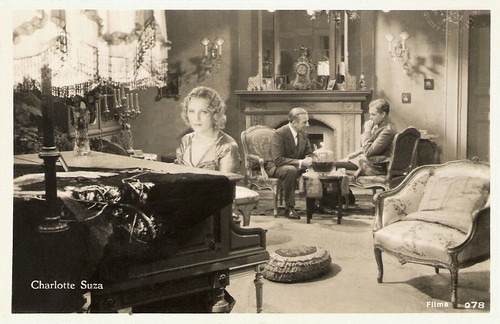
Dutch postcard by Filma, no. 278. Photo: still from Photo: still from Unter falscher Flagge/Under False Flagg (Johannes Meyer, 1932). In the background sits Gustav Fröhlich.
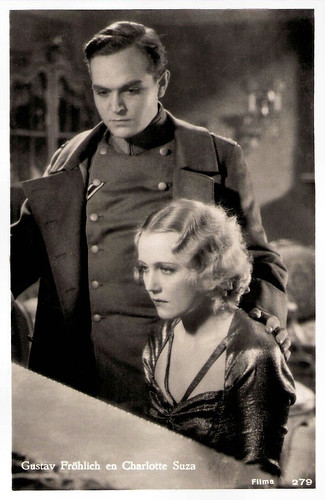
Dutch postcard by JosPe, no. 279. Photo: Filma. Publicity still for Unter falscher Flagge/Under False Flagg (Johannes Meyer, 1932) with, again, Gustav Fröhlich.
With her trained voice Charlotte Susa didn't have any difficulties to make the transition to the sound era in films like Der Tiger/The Tiger Murder Case (Johannes Meyer, 1930)), Zwei Menschen/Two Humans (Erich Waschneck, 1930), and Der Greifer/The Snatcher (Richard Eichberg, 1930).
She had again great successes with Die Pranke/The Paw (Hans Steinhoff, 1931), and Unter falscher Flagge/Under False Colours (Johannes Meyer, 1932).
Susa played mostly lighthearted Femme Fatales and was popular enough for MGM to offer her a contract in 1932. She remained in Hollywood until 1934 but failed to appear in a single feature film.
Back in Germany she made films like Henker, Frauen und Soldaten/Hangmen, Women and Soldiers (Johannes Meyer, 1935), and Wasser für Canitoga/Water for Canitoga (Herbert Selpin, 1939) at Hans Albers' side.
Hans J. Wollstein at AllMovie: "Her return to Germany was highly anticipated but she ran afoul of Joseph Goebbels, the infamous Nazi minister of propaganda, and was banned from screen work in 1941."
Her last film part was a minor role in the comedy Der Gasmann/The Gas Meter Reader (Carl Froelich, 1941) starring Heinz Rühmann and Anny Ondra. This film was her last work for the screen.
Charlotte Susa was married to Paul Cablin, Fritz Malkowsky, and from 1939 on to actor Andrews Engelmann. After the war, she acted again for the theatre, often at Engelmann's side. Charlotte Susa died in Basel, Switzerland, aged 78.
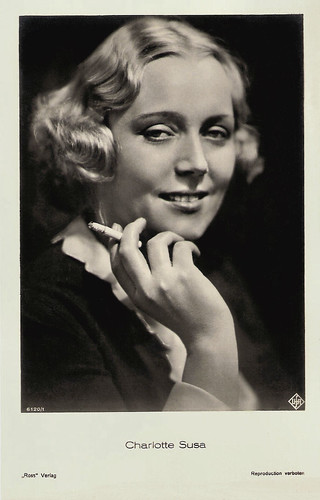
German postcard by Ross Verlag, no. 6120/1, 1931-1932. Photo: Ufa.
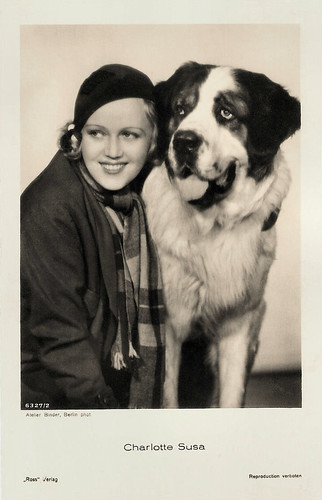
German postcard by Ross Verlag, no. 6327/2, 1931-1932. Photo: Atelier Binder, Berlin.

German postcard by Ross Verlag, no. 6785/1, 1931-1932. Photo: Alex Binder, Berlin.

Austrian postcard by Iris, no. 6659. Photo: Zander & Labisch.
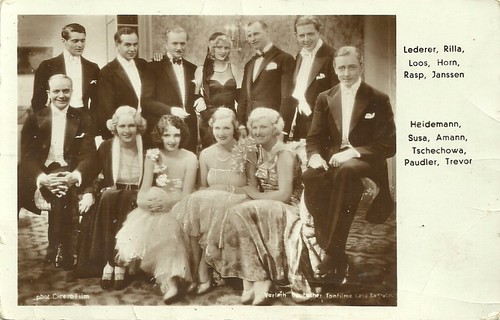
German postcard. Photo: Cicero Film / Distribution Deutsche Tonfilme. The 'fine fleur' of late silent German cinema stars, united for a photo for an early sound film company. Standing left to right: Francis/Franz Lederer, Walter Rilla, Theodor Loos, Camilla Horn, Fritz Rasp and Walter Janssen. Sitting left to right: Paul Heidemann, Charlotte Susa, Betty Amann, Olga Tschechowa, Maria Paudler and Jack Trevor. It was a publicity still for the early sound comedy Die grosse Sehnsucht/The Great Longing (Stefan Szekely/Steve Sekely, 1930), in which all acted, mostly as themselves - only Loos and Horn played characters. The plot was an excuse for 35 stars to debut in a talking picture.
Sources: Thomas Staedeli (Cyranos), Hans J. Wollstein (AllMovie), Wikipedia, and IMDb.
Last updated on 14 May 2020.

Austrian postcard by Iris Verlag, no. 5843. Photo: Verleih Ifuk Film / Delog Film. Charlotte Susa in Zapfenstreich am Rhein/Tattoo on the Rhine (Jaap Speyer, 1930).

Austrian postcard by Iris Verlag, no. 5844. Photo: Verleih Ifuk Film / Delog Film. Charlotte Susa in Zapfenstreich am Rhein/Tattoo on the Rhine (Jaap Speyer, 1930).

French postcard by Ross, no. 5122/1, 1930-1931. Photo: Ufa. Charlotte Susa in Der Tiger/The Tiger Murder Case (Johannes Meyer, 1930).

German postcard by Ross Verlag, no. 5522/1, 1930-1931. Photo: Deutsche Universal Film. Publicity Still for Zwei Menschen/Two People (Erich Waschneck, 1930) with Gustav Fröhlich.

German postcard by Ross Verlag, no. 5531/2, 1930-1931. Photo: Harlip, Berlin.
Superior Singer
Charlotte Susa (sometimes written as Suza) was born Charlotta Wegmüller near Memel, Germany (now Klaipeda, Lithuania).
In 1915, she first appeared at a stage in Tilsit. She chose her mother's maiden name, Susa, as her stage name and began a successful career as a singer and actress at different German Opera and Operetta stages.
She was as well a superior singer as a competent dramatic actress. In 1926, director Richard Eichberg spotted her for the cinema. Susa made her film debut in the German silent film Der Prinz und die Tänzerin/The Prince and the Dancer (Richard Eichberg, 1926) opposite Hans Albers.
More silent films followed like Arme kleine Colombine/Poor Little Columbine (Franz Seitz, 1927), Die Pflicht zu schweigen/The Obligation to Remain Silent (Carl Wilhelm, 1928), and Du sollst nicht stehlen/Thou Art Not Steal (Victor Janson, 1928).
Susa became famous for her roles as a femme fatale in films like Sünde und Moral/Sin and Morals (Erich Kober, 1929), and Erotikon/Seduction (Gustav Machatý, 1929).

German postcard by Ross Verlag, no. 5840/1, 1930-1931. Photo: Ufa.

Dutch postcard by JosPe, Arnhem, no. 380, with Gustav Fröhlich in Zwei Menschen/Two People (Erich Waschneck, 1930). Photo: Remaco.

Dutch postcard by Filma, no. 278. Photo: still from Photo: still from Unter falscher Flagge/Under False Flagg (Johannes Meyer, 1932). In the background sits Gustav Fröhlich.

Dutch postcard by JosPe, no. 279. Photo: Filma. Publicity still for Unter falscher Flagge/Under False Flagg (Johannes Meyer, 1932) with, again, Gustav Fröhlich.
Lighthearted Femme Fatales
With her trained voice Charlotte Susa didn't have any difficulties to make the transition to the sound era in films like Der Tiger/The Tiger Murder Case (Johannes Meyer, 1930)), Zwei Menschen/Two Humans (Erich Waschneck, 1930), and Der Greifer/The Snatcher (Richard Eichberg, 1930).
She had again great successes with Die Pranke/The Paw (Hans Steinhoff, 1931), and Unter falscher Flagge/Under False Colours (Johannes Meyer, 1932).
Susa played mostly lighthearted Femme Fatales and was popular enough for MGM to offer her a contract in 1932. She remained in Hollywood until 1934 but failed to appear in a single feature film.
Back in Germany she made films like Henker, Frauen und Soldaten/Hangmen, Women and Soldiers (Johannes Meyer, 1935), and Wasser für Canitoga/Water for Canitoga (Herbert Selpin, 1939) at Hans Albers' side.
Hans J. Wollstein at AllMovie: "Her return to Germany was highly anticipated but she ran afoul of Joseph Goebbels, the infamous Nazi minister of propaganda, and was banned from screen work in 1941."
Her last film part was a minor role in the comedy Der Gasmann/The Gas Meter Reader (Carl Froelich, 1941) starring Heinz Rühmann and Anny Ondra. This film was her last work for the screen.
Charlotte Susa was married to Paul Cablin, Fritz Malkowsky, and from 1939 on to actor Andrews Engelmann. After the war, she acted again for the theatre, often at Engelmann's side. Charlotte Susa died in Basel, Switzerland, aged 78.

German postcard by Ross Verlag, no. 6120/1, 1931-1932. Photo: Ufa.

German postcard by Ross Verlag, no. 6327/2, 1931-1932. Photo: Atelier Binder, Berlin.

German postcard by Ross Verlag, no. 6785/1, 1931-1932. Photo: Alex Binder, Berlin.

Austrian postcard by Iris, no. 6659. Photo: Zander & Labisch.

German postcard. Photo: Cicero Film / Distribution Deutsche Tonfilme. The 'fine fleur' of late silent German cinema stars, united for a photo for an early sound film company. Standing left to right: Francis/Franz Lederer, Walter Rilla, Theodor Loos, Camilla Horn, Fritz Rasp and Walter Janssen. Sitting left to right: Paul Heidemann, Charlotte Susa, Betty Amann, Olga Tschechowa, Maria Paudler and Jack Trevor. It was a publicity still for the early sound comedy Die grosse Sehnsucht/The Great Longing (Stefan Szekely/Steve Sekely, 1930), in which all acted, mostly as themselves - only Loos and Horn played characters. The plot was an excuse for 35 stars to debut in a talking picture.
Sources: Thomas Staedeli (Cyranos), Hans J. Wollstein (AllMovie), Wikipedia, and IMDb.
Last updated on 14 May 2020.
1 comment:
What a lovely face. I am so glad you are bringing these wonderful actors from time past forward into this age.
Post a Comment